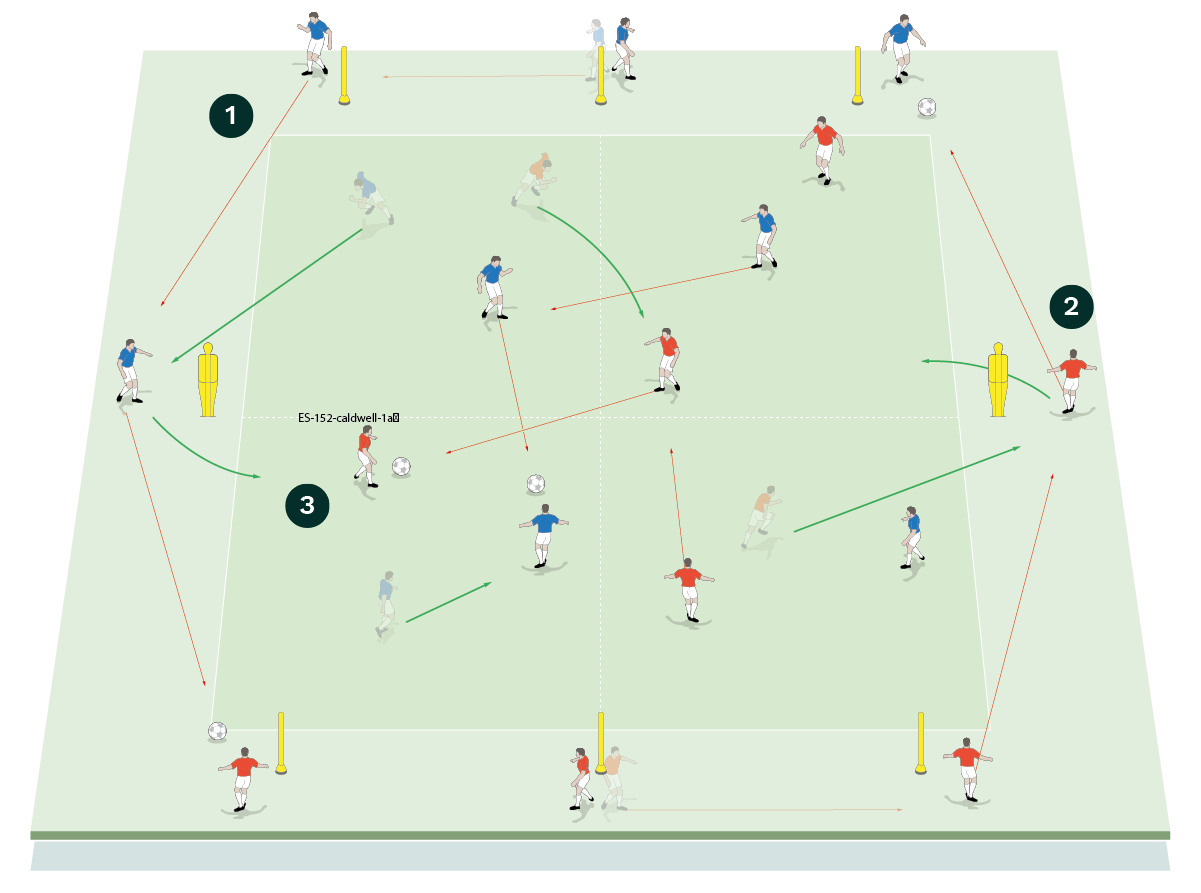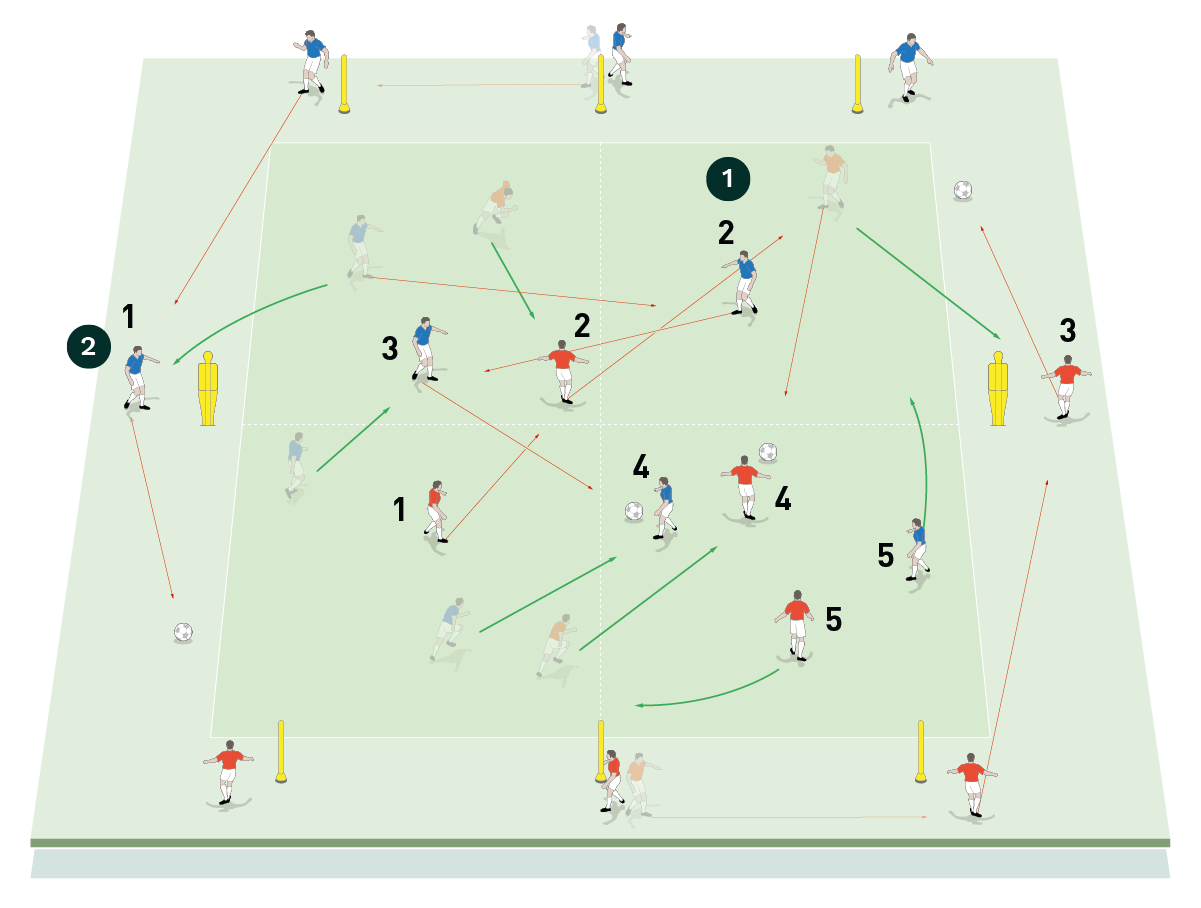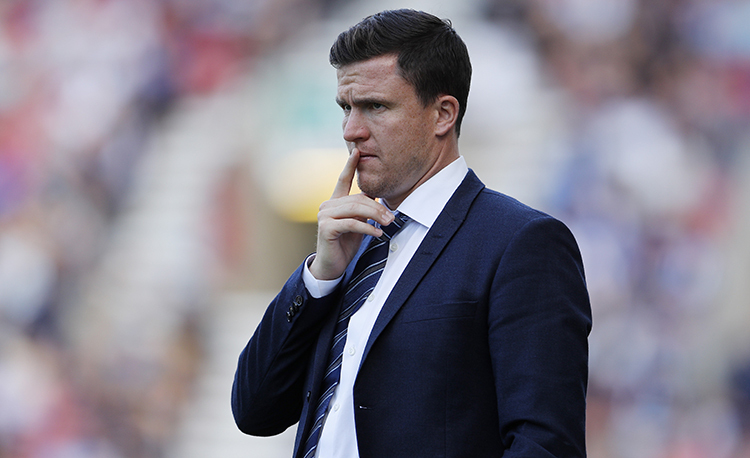




OUR BEST EVER OFFER - SAVE £100/$100
JOIN THE WORLD'S LEADING PROFESSIONAL DEVELOPMENT PROGRAMME
- 12 months membership of Elite Soccer
- Print copy of Elite Player & Coach Development
- Print copy of The Training Ground
You are viewing 1 of your 1 free articles
PASSING AND RECEIVING
| Area | 20x20 yards |
| Equipment | Balls, bibs, cone, 6 poles, 2 mannequins |
| No. of Players | 16 players |
| Session Time | 10-12mins |
In this session, technical, physical and social elements combine into a passing and receiving practice that works on all elements of passing and receiving, including first touch, awareness, scanning and communication, along with some position specific work.
This practice allows the coach to work on some very relevant areas of passing and receiving. Players must be aware of what is happening inside and outside the pitch. They need to communicate to help each other and they need to be able to think ahead about where and when they need to receive and where they will be playing the next pass to.
This is all done at pace with two teams working at once to create chaos. To help players, we use a gridded area in the centre to offer some positional reference points.
This session’s multifaceted nature allows coaches to concentrate on a particular area of passing and receiving or just let the session flow, depending on player aptitude and understanding. After running it a few of times, players will have clarity on the rules and then be better able to focus on the detail.
As a training activity, it promotes good habits, gets the players to think while playing and successfully engages them before going into a possession-based practice or game-based session.
This activity was designed and implemented to highlight the areas we wanted players to focus on within passing and receiving but also to highlight that we are willing to try new and different ways of doing things, knowing we may get it wrong.
This was highlighted to the players before we ran it for the first time and we asked for feedback after the session, which led to a couple of changes.
Having just taken over at a club where change is rare, this opened up a line of discussion, reinforced what we wanted from the players, and allowed us to try something new and relevant to the evolving nature of things on the pitch, having just stepped up into League One.
PASS AND RECEIVE
We set up a playing area of 20x20 yards that is divided into four 10x10-yard boxes. We position six poles outside the playing area, with three on each side, and one mannequin is placed on each of the other two sides, as shown.
We’re using 16 outfield players split into two teams of eight. Each team starts with five players in the main playing area. The three remaining players (central defenders or midfield players) are positioned with one behind each pole on the outside; the three reds are behind the poles on one side and the three blues are behind the poles on the other side.
Two balls are in play simultaneously in the main playing area, one per team. Both teams pass and receive within their teams, using two touches maximum. Players can’t pass the ball to someone in the same grid box as them.
On the outside, two balls are passed around the area – the players pull off to receive the ball behind their pole, replicating dropping to receive and creating an angle to switch the ball, as shown [1a].
[1a]

- One ball is in play per team in the central grid. Each team passes their ball between themselves. Players are restricted to two touch
- Players can’t pass the ball to someone in the same grid box as them
- On the outside, two more balls are passed around the area by the players on the poles
[1b]

- As the ball nears the third pole on each side, the third player looks to pass the ball behind the mannequin
- A player from inside the main area must make a run to receive the ball from behind the line of the mannequin and transfer it to the first pole on the opposite side
- The players in the centre continue passing and receiving and the player who made the outside run re-joins them. The same player cannot go outside to receive twice in a row
As the ball nears the third player behind the poles, a player from the main central area must pull out to receive the ball from behind the line of the mannequin and transfer it to the opposite side, replicating receiving through a line and playing forward, as shown [1b].
The players in the centre continue passing and receiving while this happens and the players that made the runs outside the mannequins on each side return to the middle once they have played the ball to the opposite side. The same player cannot go outside to receive twice in a row.
We can progress the activity by numbering the players inside the grid from one to five on each team. Then we restrict the players to passing and receiving the inside ball in the correct numerical order (player one passes to player two, player two passes to player three etc), while still making the time and space for one player to pull out to the mannequin to receive and pass the outside ball, as shown [1c].
Other progressions can include restricting players to one touch followed by two-touch on the inside, and making it a race between the red and blue teams to have every middle player receive on the outside.
This is an activation type drill for us so we would run the basic activity in 90-second rounds for 10 to 12 minutes with progressions throughout.
[1c]

- Progress the activity by numbering the players inside the grid from one to five on each team. The players are restricted to passing and receiving the inside ball in the correct numerical order
- Players must concentrate and communicate to enable one of them to make the time and space to run to receive the outside ball behind the mannequin
“The players are restricted to passing and receiving the inside ball in the correct numerical order”
COACHING POINTS
What are the key things to look for?
We want to see that players are aware of where and when they need to be moving to receive, that they know what the next pass is going to be, and that they are communicating with each other throughout.
If the inside players are getting the timing right and are aware of when they need to go out to receive, it will show in the quality and flow of the passing and receiving – balls shouldn’t collide in the middle and the outside balls should be moving quickly with minimal disruption.
Communication is vital for passing and receiving and this practice allows for players to work on this with each other.
What are the typical mistakes players might make and how do I avoid them?
The outside balls may stall due to players on the inside not being aware that they need to go out to receive. This can be remedied by better communication.
Sometimes the players can display poor passing and receiving skills because they are not concentrating on the most important thing and are caught up with the movement of other players and other balls.
Also, players are sometimes left standing still due to not knowing where the next pass is coming from – to improve this, we encourage players to keep scanning and being aware of when their team mates need them.
Related Files
Editor's Picks
Attacking transitions
Deep runs in the final third
Using the goalkeeper in build-up play
Intensive boxes drill with goals
Penetrating the final third
Creating and finishing
My philosophy
Pressing initiation
Compact team movement
Coaches' Testimonials

Alan Pardew

Arsène Wenger

Brendan Rodgers

Carlos Carvalhal

José Mourinho

Jürgen Klopp

Pep Guardiola

Roy Hodgson

Sir Alex Ferguson

Steven Gerrard
Coaches' Testimonials

Gerald Kearney, Downtown Las Vegas Soccer Club

Paul Butler, Florida, USA

Rick Shields, Springboro, USA

Tony Green, Pierrefonds Titans, Quebec, Canada
Join the world's leading coaches and managers and discover for yourself one of the best kept secrets in coaching. No other training tool on the planet is written or read by the calibre of names you’ll find in Elite Soccer.
In a recent survey 92% of subscribers said Elite Soccer makes them more confident, 89% said it makes them a more effective coach and 91% said it makes them more inspired.
Get Monthly Inspiration
All the latest techniques and approaches
Since 2010 Elite Soccer has given subscribers exclusive insight into the training ground practices of the world’s best coaches. Published in partnership with the League Managers Association we have unparalleled access to the leading lights in the English leagues, as well as a host of international managers.
Elite Soccer exclusively features sessions written by the coaches themselves. There are no observed sessions and no sessions “in the style of”, just first-hand advice delivered direct to you from the coach.







